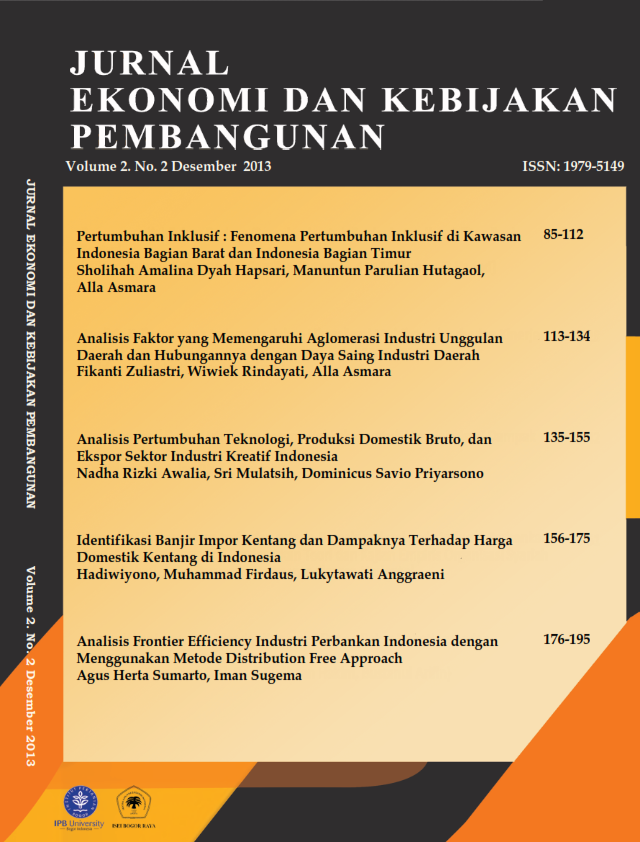ANALISIS PERTUMBUHAN TEKNOLOGI, PRODUK DOMESTIK BRUTO, DAN EKSPOR SEKTOR INDUSTRI KREATIF INDONESIA
Abstract
Creative industries are seen to be important for the economic well-being, proponents suggesting that human creativity is the ultimate economic resource. This research seeks to explore the technology progress measured by total factor productivity (TFP) growth of creative industry in Indonesia, analyze how external factors influence GDP of creative industry (education, TFP growth, the number of companies, the number of labors, and government policy), and analyze the causality between GDP and export of creative industry using Granger Causality Test. This research uses panel data, representing pooled of time series data (year 2006-2013) and cross section data (14 subsectors of creative industry). The results shows that (1) TFP growth of 4 creative industry subsectors are negative: architecture, interactive games, computer programs, and research and development; (2) factors influencing the GDP of creative industry positively: education, TFP growth, the number of labors, and government policy; (3) there is two-way-causality between GDP and export of creative industry.
Keywords: creative industry, TFP, panel data, Granger causality.
References
Case, K. E., Fair R. C. 2007.Prinsipprinsip Ekonomi Jilid I. Edisi kedelapan. Erlangga. Jakarta.
Garnham, N. 2005. From Cultural to Creative Industries: An Analysis of The Implications of The ‘Creative Industries’ Approach to Arts and Media Policy Making in United Kingdom. International Journal of Culture Policy, Volume 11, No.1.
Gujarati, D. 2004. Basics Econometrics.Fourth Edition.The Megraw-Hill Companies. New York.
Kemendag. 2008. Pengembangan Ekonomi Kreatif Indonesia 2025. Kementerian Perdagangan. Jakarta.
Kemenparekraf. 2013. Data Statistik. Pusat Data dan Informasi. Kementerian Pariwisata dan Ekonomi dan Kreatif. Jakarta.
Khristianto, W. 2008.Peluang dan Tantangan Industri Kreatif di Indonesia. Jurnal Bisnis dan Manajemen, Volume 5, No.1: 33- 48.
Kuncoro, M. 2010. Visi Indonesia 2030: Quo Vadis? Universitas Gajah Mada. Yogyakarta.
Mahyuddin, Juanda, B., Siregar, H. 2006. Total Factor Productivitydan Dampaknya Terhadap Kesempatan Kerja di Provinsi Sulawesi Selatan. Jurnal Sosial Ekonomi Pertanian No 23.
Mankiw, N.G.. 2007. Makroekonomi. Edisi Keenam. Liza F, penerjemah; Hardani W, editor. Jakarta: Erlangga. Terjemahan dari: Macroeconomics. Sixth Edition. Harper and Row Publisher. New York.
Maslow, A. 1984, Motivasi dan Kepribadian, Seri Manajemen No. 104. Cetakan Pertama. PT. Pustaka. Jakarta.
Mehrara, M., Firouzjaee B. A. 2011. Granger Causality between Export Growth and GDP Growth in Developing Countries. International Journal of Humanities and Social Science, Volume 1, No.16.
Mikić, H. 2012. Public policy and creative industries in Serbia. Dalam: 7th International Conference on Cultural Policy Research. Proceeding of a workshop held in Barcelona, Spain, 9-12 July 2012.
Rani, P. 2011. Impact of Technology on Creative Industries: A Study of The Indian Film Industry. Dalam: International Search Conference. Proceeding of a workshop held in Kuala Lumpur, Malaysia, 28-29 May 2011.
Rianse, U. 2013. Peran Pemerintah dan Perguruan Tinggi dalam Pengembangan Ekonomi Kreatif Berbasis Budaya Lokal. Dalam: Kongres Kebudayaan Indonesia (KKI) di Yogyakarta, Indonesia, 8-11 Oktober 2013.
Winarno, W. W. 2009. Analisis Ekonometrika dan Statistika dengan Menggunakan Eviews. STIM YKPN, Yogyakarta.
Sebayang, L.R. 2012.Analisis Prospek Ekspor Industri Kreatif dalam Meningkatkan Perekonomian Indonesia. Tesis. Program Pascasarjana. Universitas Sumatera Utara, Medan.
Zhang, J., Kloudova, J. 2011. Factors which Influence the Growth of Creative Industries: Cross-section Analysis in China. Current Issues of Business and Law, Volume 3: 104-117.
Authors

This work is licensed under a Creative Commons Attribution-NonCommercial-ShareAlike 4.0 International License.
The authors who publis article(s) in Jurnal Ekonomi and Kebijakan Pembangunan have to understand and agree that the copyright of article published is owned by Jurnal ekonomi and Kebijakan pembangunan including to reproduce, distribute and sell this journal to public.

